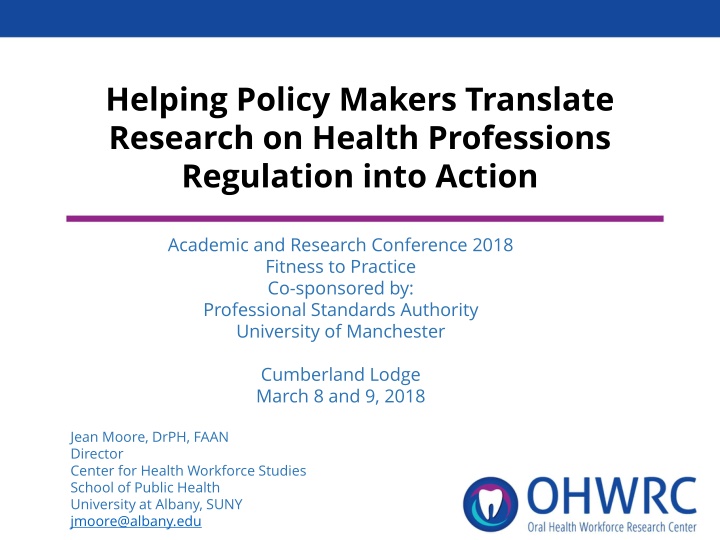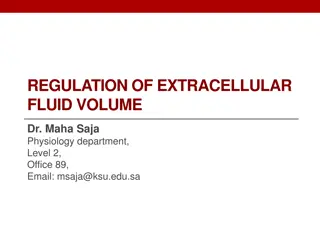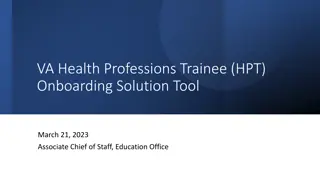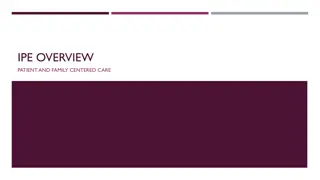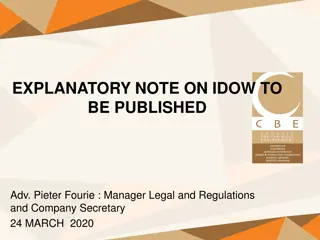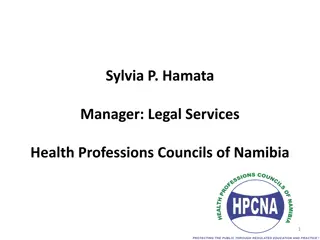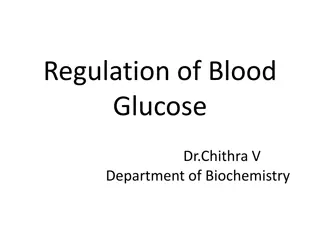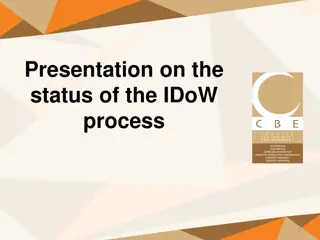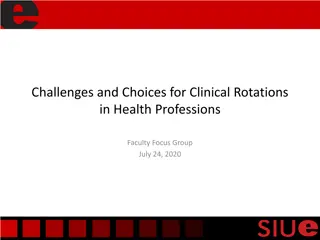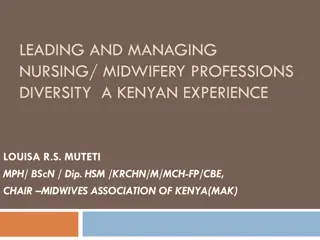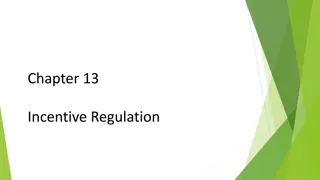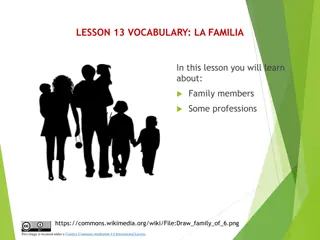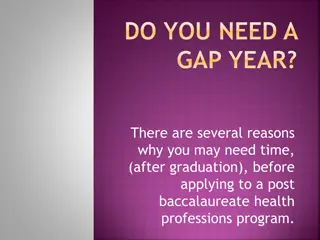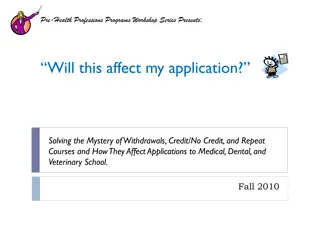Transforming Health Professions Regulation: Insights from 2018 Conference
Explore key findings from the 2018 Academic Conference on Health Professions Regulation, focusing on translating research into actionable policies. Topics include workforce dynamics, value-based care in oral health, and innovative workforce strategies to enhance patient outcomes.
Download Presentation

Please find below an Image/Link to download the presentation.
The content on the website is provided AS IS for your information and personal use only. It may not be sold, licensed, or shared on other websites without obtaining consent from the author.If you encounter any issues during the download, it is possible that the publisher has removed the file from their server.
You are allowed to download the files provided on this website for personal or commercial use, subject to the condition that they are used lawfully. All files are the property of their respective owners.
The content on the website is provided AS IS for your information and personal use only. It may not be sold, licensed, or shared on other websites without obtaining consent from the author.
E N D
Presentation Transcript
Helping Policy Makers Translate Research on Health Professions Regulation into Action Academic and Research Conference 2018 Fitness to Practice Co-sponsored by: Professional Standards Authority University of Manchester Cumberland Lodge March 8 and 9, 2018 Jean Moore, DrPH, FAAN Director Center for Health Workforce Studies School of Public Health University at Albany, SUNY jmoore@albany.edu
The OHWRC at CHWS The Center for Health Workforce Studies (CHWS) has more than 20 years experience studying all aspects of the health workforce: oEstablished in 1996 oA research center of the University at Albany School of Public Health oCommitted to collecting and analyzing data to understand workforce dynamics and trends oGoal to inform public policies, the health and education sectors, and the public oBroad array of funders in support of health workforce research This study was funded under a Cooperative Agreement with the federal Health Resources and Services Administration (HRSA) for an Oral Health Workforce Research Center (OHWRC) based at CHWS oralhealthworkforce.org 2
Acknowledgements Researchers who contributed to this work included Margaret Langelier, M.S.; Tracey Continelli, PhD; Simona Surdu, MD, PhD; Bridget Baker, MA; and Rachel Carter The American Dental Hygiene Association which helped to organize dental hygiene focus groups to inform this work oralhealthworkforce.org 3
The Changing Oral Health Landscape: Growing Attention to Value Based Care Increasing emphasis on improving oral health literacy Focus on prevention and early intervention in disease process Recognition of importance of risk assessment to triage patients to most appropriate level of care. Interest in the use of technology to improve access and navigate patients to appropriate providers through applications of teledentistry Integration of oral health services with primary care oralhealthworkforce.org 4
Workforce Impacts Use of team-based models of care New workforce strategies o Community dental health coordinator o Dental therapists o Expanded function dental assistants o Public health dental hygienists o Dental therapists, dental hygiene therapists Engagement of medical professionals o Training primary care clinicians to screen and refer and medical assistants and nurses in application of fluoride, especially for children Expansion in scope of practice o DHs - once viewed as dental extender, now preventive oral health specialist oralhealthworkforce.org 5
Key Elements in SOP Research Identify a health profession with state to state variation in SOP Develop a tool that can systematically measure variation Assess impacts of SOP variation on health outcomes Translate SOP research findings for policy- makers oralhealthworkforce.org 6
Dental Hygiene Professional Practice Index DH scope of practice (SOP) varies considerably by state o Variation believed to impact access to care Dental Hygiene Professional Practice Index developed in 2001 o grouped numerous variables into 1 of 4 categories: Regulation, supervision, tasks, and reimbursement Numerical scoring based on each state s law and regulation o Possible composite score from 0-100 2001 DHPPI o Used to score state DH SOP in 2001 and re-scored in 2014 2016 DHPPI o Updated index (revised variables) and scored state DH SOP in 2016 oralhealthworkforce.org 7
State Level DHPPI Scores, 2001 and 2014 Variables grouped into one of four categories: Regulation, supervision, tasks, and reimbursement Scoring based on a review of state law and regulation in each state Possible composite score from 0-100 Descriptive analysis 2001 scores ranged from 10 in West Virginia to 97 in Colorado 2014 scores ranged from 18 in Alabama and Mississippi to 98 in Maine. Mean score on the DHPPI progressed from 43.5 in 2001 to 57.6 in 2014 Statistical analysis In 2001, SOP was positively correlated with the percent of the population in a state having their teeth cleaned by a dentist or dental hygienist within the past year. In 2014, exploratory and confirmatory factor analysis confirmed that the component structures were all aspects of the overarching concept in this case scope of practice o o o o o oralhealthworkforce.org 8
Does DH SOP Matter? Research question: Do more expansive SOPs, which allow more autonomy in preventive services delivery in public health settings, impact oral health outcomes in the population? In 2014, we used Multilevel logistic modeling with the DHPPI and BRFSS data controlling for state and individual level factors including community water fluoridation, demographic and socioeconomic factors Individual level data describing the oral health status and service utilization of individuals in states from the CDC s Behavioral Risk Factor Surveillance System (BRFSS) Finding: More expansive SOP for DHs in states was positively and significantly associated (p<0.05) with having no teeth removed due to decay or disease among individuals in those states Langelier M, Continelli T, Moore J, Baker B, Surdu S. Expanded scopes of practice for dental hygienists associated with improved oral health outcomes for adults. Health Affairs. 2016; 35(12); doi: 10.1377/hlthaff.2016.0807. oralhealthworkforce.org 9
The 2016 DHPPI Finding from 2014 update variables in 2001 DHPPI no longer adequately represented SOP Dental hygienists now seen as experts in prevention education and services o More autonomous roles o Team based care o New technologies o New settings for care delivery o Point of entry - case finding o Roles as case managers/patient navigators Design process for the new DHPPI included focus groups with dental hygienists o Some variables were retained or modified o New variables were added o Fewer variables overall o Scoring weights were redistributed o New variables e.g., dental hygiene therapy, use of lasers, and basic restorative tasks Factor analysis again confirmed the integrity of the construct As expected, scores were lower on the new index o Range of scores was 7 in Mississippi to 86 in Maine oralhealthworkforce.org 10
Changing Scope of Practice for Dental Hygienists 2001, 2014, and 2016 High scoring states in 2014 were also high scoring on the new index (e.g., ME, CO, CA, WA, NM were each classified as excellent environments at each scoring) Some states were innovators in expanding practice opportunities for dental hygienists (e.g., MN with advanced dental therapy, VT recently enabled dental therapy; the model requires professionals to also be dental hygienists) Other states used a slower, more incremental approach to increasing scope of practice (e.g., IA classified as satisfactory at each scoring) Some low scoring states were consistently low scoring (e.g., GA, MS, NC classified as restrictive at each scoring) oralhealthworkforce.org 11
Some Examples of the Impact of Expanded SOP on Access to Care in Community Settings A dental hygienist owns an independent practice in Colorado with a fixed clinic and mobile van that provides services to residents of a municipal housing project and to seniors in rural areas Dental hygienists work in a Virtual Dental Home providing atraumatic restorations to children in California and Oregon using teledentistry applications. Advanced dental therapists provide preventive and restorative services to underserved populations in Minnesota s federally qualified health centers and other community clinics A public health dental hygienist with certification as a community dental health coordinator provides preventive services in primary care physician practices in Pennsylvania A public health dental hygienist works in nursing homes in New Hampshire providing routine preventive services and case management Dental hygienist entrepreneurs in Nevada and South Carolina own school linked oral health programs providing a range of preventive services to thousands of school children annually oralhealthworkforce.org 12
Developing a Dental Hygiene SOP Infographic: Why and How Research finds that broader SOPs for DHs are associated with better oral health outcomes in a state There is substantial variation in DH SOP across states, but no tools to help policy makers understand these differences OHWRC in collaboration with ADHA conducted a series of focus groups of dental hygiene leaders from across the country to identify the key DH functions and tasks to include in the of the infographic oralhealthworkforce.org 13
DH Tasks and Functions Included in the Infographic Dental hygiene diagnosis Prescriptive authority Level of supervision for administering local anesthesia Supervision of dental assistants Direct Medicaid reimbursement Dental hygiene treatment planning Provision of sealants without prior examination Direct access to prophylaxis from a dental hygienist oralhealthworkforce.org 14
Conclusions and Next Steps SOP is an important consideration when designing workforce strategies to increase access to and utilization of preventive oral health services Placing DHs in community settings and enabling service delivery with autonomy within professional competencies may improve outcomes Currently analyzing data to determine the impact of scope of practice on access to oral health services and on oral health outcomes for children Infographic is a work in progress, i.e., requires routine updating as states modify DH practice requirements oralhealthworkforce.org 16
